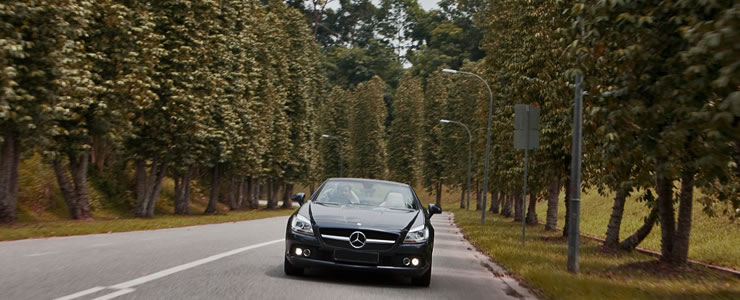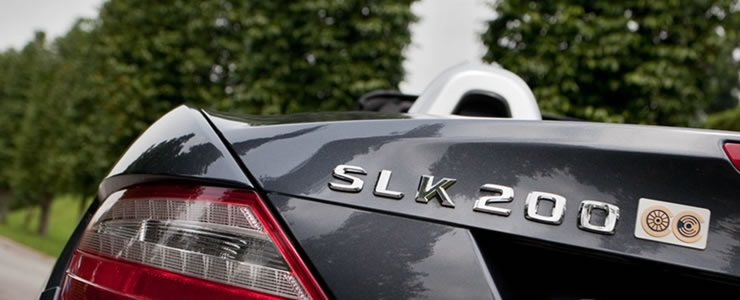Mercedes-Benz SLK200 BlueEfficiency (A) Review
05 Oct 2011|18,560 views
My earliest memory of the SLK was reading about it in a now-defunct local publication when the car was first launched, back in 1996. At the time, the SLK made quite a wave in the automotive world, as it was the first modern, mass-production car with a folding hard-top roof.
Since then, the folding metal roof concept has found its way onto lots of other drop tops, and the SLK lost its novelty value. As a result, Mercedes-Benz has had to work harder to make its baby roadster stand out further.
The second generation SLK was a huge leap forwards over the first model, in terms of driving dynamics, yet somehow it fell just short of challenging the class leader, namely the Porsche Boxster.
But it provided an indication as to what Mercedes-Benz could do for its baby, and now it has tried again, with the all-new third generation SLK. Can this new model improve on its predecessor's good work?
Exterior
The all-new SLK has been almost completely redesigned from the ground up. At least, according to Mercedes-Benz. And while the basic silhouette is still unmistakably SLK, the car is noticeably butcher and more muscular than the previous two generations.
Since then, the folding metal roof concept has found its way onto lots of other drop tops, and the SLK lost its novelty value. As a result, Mercedes-Benz has had to work harder to make its baby roadster stand out further.
The second generation SLK was a huge leap forwards over the first model, in terms of driving dynamics, yet somehow it fell just short of challenging the class leader, namely the Porsche Boxster.
But it provided an indication as to what Mercedes-Benz could do for its baby, and now it has tried again, with the all-new third generation SLK. Can this new model improve on its predecessor's good work?
Exterior
The all-new SLK has been almost completely redesigned from the ground up. At least, according to Mercedes-Benz. And while the basic silhouette is still unmistakably SLK, the car is noticeably butcher and more muscular than the previous two generations.
 |
There are noticeable design cues that are inspired by Mercedes-Benz's SLS AMG supercar, such as the front grille with the imposing three-pointed star badge, the slightly raked-back headlamps, and the air vents at the top of the bonnet, just before the windscreen.
The chrome vent on the front fenders lend a distinctive touch to the SLK's side profile, and the smooth lines easing towards the flat and low rear end make the car appear tauter than before. The SLK is relatively short and wide too, and those dimensions only serve to accentuate those lines.
It is a design that grows on you, and once you've got used to it, you can't deny that the new SLK is a stunning little thing. It probably ranks as one of the most stylish-looking roadsters out on the market.
 |
Interior
The SLS AMG theme continues inside, with the thick-set centre console, brushed in an aluminium look, and the round air vents, which work brilliantly and gives the interior a classy feel. The cabin itself seems relatively well-built, but space is a bit tight even as a two-seater.
The seats are very low, even at its highest setting, and while this gives the occupants a sporty sensation, there might be a slight effect on visibility. Blind spots are amplified with the roof up, but as they become eliminated with the top down, it becomes a moot point anyway.
Speaking of which, the roof itself works well, folding in less than 20 seconds. The controls are covered up, and located on the centre console, but seem a bit counter-intuitive in their action. The lever requires one to pull it to retract the roof, and push for the opposite. The car also has to be completely stationary for the roof to be operable.
The SLS AMG theme continues inside, with the thick-set centre console, brushed in an aluminium look, and the round air vents, which work brilliantly and gives the interior a classy feel. The cabin itself seems relatively well-built, but space is a bit tight even as a two-seater.
The seats are very low, even at its highest setting, and while this gives the occupants a sporty sensation, there might be a slight effect on visibility. Blind spots are amplified with the roof up, but as they become eliminated with the top down, it becomes a moot point anyway.
Speaking of which, the roof itself works well, folding in less than 20 seconds. The controls are covered up, and located on the centre console, but seem a bit counter-intuitive in their action. The lever requires one to pull it to retract the roof, and push for the opposite. The car also has to be completely stationary for the roof to be operable.
For this latest generation SLK, Mercedes-Benz has a new feature, called Magic Sky Control, available as an option (but not featured on our test car). Basically, the roof becomes a glass panel, and the tint can be darkened or lightened at a push of a button.
Other optional equipment for the SLK include the AirScarf which blows warm air onto the passenger's necks, the novel wind deflector, called AirGuide, which consists of two plastic flaps behind the headrests that can be adjusted, and the Intelligent Light System with LED daytime running lights.
Boot space, at 335 litres with the roof up, is reasonable for a roadster, but is naturally compromised once the roof is down, dropping to a mere 225 litres. Still, it should be enough to accommodate most small bags.
Other optional equipment for the SLK include the AirScarf which blows warm air onto the passenger's necks, the novel wind deflector, called AirGuide, which consists of two plastic flaps behind the headrests that can be adjusted, and the Intelligent Light System with LED daytime running lights.
Boot space, at 335 litres with the roof up, is reasonable for a roadster, but is naturally compromised once the roof is down, dropping to a mere 225 litres. Still, it should be enough to accommodate most small bags.
 |
The Drive
The 1.8-litre engine that powers this base SLK200 version churns out 184bhp, and while that is adequate for this compact roadster, it just doesn't feel lively enough to provide that spark which comes when driving this sort of car.
Instead, the engine is a smooth operator, delivering its power in a refined fashion in tandem with the 7G-Tronic 7-speed automatic gearbox. Sport mode sharpens up the response just a tad, but it's a barely noticeable difference.
But, as the Mazda MX-5 showed, a roadster does not need immense power to be enjoyable. And the SLK, to its credit, does feel rather nimble in the corners, thanks to its short dimensions. A bit of fun can be had, but one really has to push the car hard in order to flick the tail out, as the SLK's natural instinct is to remain planted and safe.
The steering feels neutral, and the car responds well to driver input, but the major surprise was the ride. On standard suspension, the car feels mostly well-damped, soaking all but the harshest of bumps well.
Overall, with its decent powerplant, composed handling, surprisingly pliant ride and general refinement, the SLK is a pleasant all-rounder.
The 1.8-litre engine that powers this base SLK200 version churns out 184bhp, and while that is adequate for this compact roadster, it just doesn't feel lively enough to provide that spark which comes when driving this sort of car.
Instead, the engine is a smooth operator, delivering its power in a refined fashion in tandem with the 7G-Tronic 7-speed automatic gearbox. Sport mode sharpens up the response just a tad, but it's a barely noticeable difference.
But, as the Mazda MX-5 showed, a roadster does not need immense power to be enjoyable. And the SLK, to its credit, does feel rather nimble in the corners, thanks to its short dimensions. A bit of fun can be had, but one really has to push the car hard in order to flick the tail out, as the SLK's natural instinct is to remain planted and safe.
The steering feels neutral, and the car responds well to driver input, but the major surprise was the ride. On standard suspension, the car feels mostly well-damped, soaking all but the harshest of bumps well.
Overall, with its decent powerplant, composed handling, surprisingly pliant ride and general refinement, the SLK is a pleasant all-rounder.
Conclusion
In three generations, the SLK has gone from pretty poser car, to a serious contender in the sports roadster segment.
That is a remarkable achievement, considering the kind of competition it faces in the market.
With its combination of striking good looks, and all-round ability, the SLK is a worthy consideration for those looking for a two-seater roadster.
What do you think? Jot down your opinions at the comment box below.
In three generations, the SLK has gone from pretty poser car, to a serious contender in the sports roadster segment.
That is a remarkable achievement, considering the kind of competition it faces in the market.
With its combination of striking good looks, and all-round ability, the SLK is a worthy consideration for those looking for a two-seater roadster.
What do you think? Jot down your opinions at the comment box below.
My earliest memory of the SLK was reading about it in a now-defunct local publication when the car was first launched, back in 1996. At the time, the SLK made quite a wave in the automotive world, as it was the first modern, mass-production car with a folding hard-top roof.
Since then, the folding metal roof concept has found its way onto lots of other drop tops, and the SLK lost its novelty value. As a result, Mercedes-Benz has had to work harder to make its baby roadster stand out further.
The second generation SLK was a huge leap forwards over the first model, in terms of driving dynamics, yet somehow it fell just short of challenging the class leader, namely the Porsche Boxster.
But it provided an indication as to what Mercedes-Benz could do for its baby, and now it has tried again, with the all-new third generation SLK. Can this new model improve on its predecessor's good work?
Exterior
The all-new SLK has been almost completely redesigned from the ground up. At least, according to Mercedes-Benz. And while the basic silhouette is still unmistakably SLK, the car is noticeably butcher and more muscular than the previous two generations.
Since then, the folding metal roof concept has found its way onto lots of other drop tops, and the SLK lost its novelty value. As a result, Mercedes-Benz has had to work harder to make its baby roadster stand out further.
The second generation SLK was a huge leap forwards over the first model, in terms of driving dynamics, yet somehow it fell just short of challenging the class leader, namely the Porsche Boxster.
But it provided an indication as to what Mercedes-Benz could do for its baby, and now it has tried again, with the all-new third generation SLK. Can this new model improve on its predecessor's good work?
Exterior
The all-new SLK has been almost completely redesigned from the ground up. At least, according to Mercedes-Benz. And while the basic silhouette is still unmistakably SLK, the car is noticeably butcher and more muscular than the previous two generations.
 |
There are noticeable design cues that are inspired by Mercedes-Benz's SLS AMG supercar, such as the front grille with the imposing three-pointed star badge, the slightly raked-back headlamps, and the air vents at the top of the bonnet, just before the windscreen.
The chrome vent on the front fenders lend a distinctive touch to the SLK's side profile, and the smooth lines easing towards the flat and low rear end make the car appear tauter than before. The SLK is relatively short and wide too, and those dimensions only serve to accentuate those lines.
It is a design that grows on you, and once you've got used to it, you can't deny that the new SLK is a stunning little thing. It probably ranks as one of the most stylish-looking roadsters out on the market.
 |
Interior
The SLS AMG theme continues inside, with the thick-set centre console, brushed in an aluminium look, and the round air vents, which work brilliantly and gives the interior a classy feel. The cabin itself seems relatively well-built, but space is a bit tight even as a two-seater.
The seats are very low, even at its highest setting, and while this gives the occupants a sporty sensation, there might be a slight effect on visibility. Blind spots are amplified with the roof up, but as they become eliminated with the top down, it becomes a moot point anyway.
Speaking of which, the roof itself works well, folding in less than 20 seconds. The controls are covered up, and located on the centre console, but seem a bit counter-intuitive in their action. The lever requires one to pull it to retract the roof, and push for the opposite. The car also has to be completely stationary for the roof to be operable.
The SLS AMG theme continues inside, with the thick-set centre console, brushed in an aluminium look, and the round air vents, which work brilliantly and gives the interior a classy feel. The cabin itself seems relatively well-built, but space is a bit tight even as a two-seater.
The seats are very low, even at its highest setting, and while this gives the occupants a sporty sensation, there might be a slight effect on visibility. Blind spots are amplified with the roof up, but as they become eliminated with the top down, it becomes a moot point anyway.
Speaking of which, the roof itself works well, folding in less than 20 seconds. The controls are covered up, and located on the centre console, but seem a bit counter-intuitive in their action. The lever requires one to pull it to retract the roof, and push for the opposite. The car also has to be completely stationary for the roof to be operable.
For this latest generation SLK, Mercedes-Benz has a new feature, called Magic Sky Control, available as an option (but not featured on our test car). Basically, the roof becomes a glass panel, and the tint can be darkened or lightened at a push of a button.
Other optional equipment for the SLK include the AirScarf which blows warm air onto the passenger's necks, the novel wind deflector, called AirGuide, which consists of two plastic flaps behind the headrests that can be adjusted, and the Intelligent Light System with LED daytime running lights.
Boot space, at 335 litres with the roof up, is reasonable for a roadster, but is naturally compromised once the roof is down, dropping to a mere 225 litres. Still, it should be enough to accommodate most small bags.
Other optional equipment for the SLK include the AirScarf which blows warm air onto the passenger's necks, the novel wind deflector, called AirGuide, which consists of two plastic flaps behind the headrests that can be adjusted, and the Intelligent Light System with LED daytime running lights.
Boot space, at 335 litres with the roof up, is reasonable for a roadster, but is naturally compromised once the roof is down, dropping to a mere 225 litres. Still, it should be enough to accommodate most small bags.
 |
The Drive
The 1.8-litre engine that powers this base SLK200 version churns out 184bhp, and while that is adequate for this compact roadster, it just doesn't feel lively enough to provide that spark which comes when driving this sort of car.
Instead, the engine is a smooth operator, delivering its power in a refined fashion in tandem with the 7G-Tronic 7-speed automatic gearbox. Sport mode sharpens up the response just a tad, but it's a barely noticeable difference.
But, as the Mazda MX-5 showed, a roadster does not need immense power to be enjoyable. And the SLK, to its credit, does feel rather nimble in the corners, thanks to its short dimensions. A bit of fun can be had, but one really has to push the car hard in order to flick the tail out, as the SLK's natural instinct is to remain planted and safe.
The steering feels neutral, and the car responds well to driver input, but the major surprise was the ride. On standard suspension, the car feels mostly well-damped, soaking all but the harshest of bumps well.
Overall, with its decent powerplant, composed handling, surprisingly pliant ride and general refinement, the SLK is a pleasant all-rounder.
The 1.8-litre engine that powers this base SLK200 version churns out 184bhp, and while that is adequate for this compact roadster, it just doesn't feel lively enough to provide that spark which comes when driving this sort of car.
Instead, the engine is a smooth operator, delivering its power in a refined fashion in tandem with the 7G-Tronic 7-speed automatic gearbox. Sport mode sharpens up the response just a tad, but it's a barely noticeable difference.
But, as the Mazda MX-5 showed, a roadster does not need immense power to be enjoyable. And the SLK, to its credit, does feel rather nimble in the corners, thanks to its short dimensions. A bit of fun can be had, but one really has to push the car hard in order to flick the tail out, as the SLK's natural instinct is to remain planted and safe.
The steering feels neutral, and the car responds well to driver input, but the major surprise was the ride. On standard suspension, the car feels mostly well-damped, soaking all but the harshest of bumps well.
Overall, with its decent powerplant, composed handling, surprisingly pliant ride and general refinement, the SLK is a pleasant all-rounder.
Conclusion
In three generations, the SLK has gone from pretty poser car, to a serious contender in the sports roadster segment.
That is a remarkable achievement, considering the kind of competition it faces in the market.
With its combination of striking good looks, and all-round ability, the SLK is a worthy consideration for those looking for a two-seater roadster.
What do you think? Jot down your opinions at the comment box below.
In three generations, the SLK has gone from pretty poser car, to a serious contender in the sports roadster segment.
That is a remarkable achievement, considering the kind of competition it faces in the market.
With its combination of striking good looks, and all-round ability, the SLK is a worthy consideration for those looking for a two-seater roadster.
What do you think? Jot down your opinions at the comment box below.
Thank You For Your Subscription.

















































